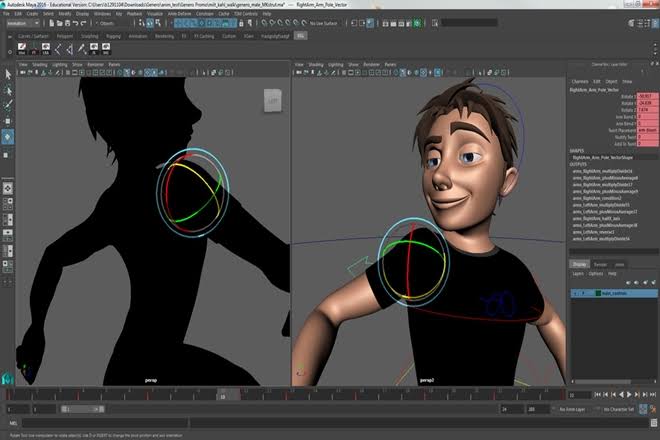
Are you passionate about creating visually stunning and immersive animations? If so, pursuing a career as a 3D animator might be the perfect fit for you. In this blog post, we will explore the world of 3D animation and provide valuable insights into what it takes to become a successful 3D animator. From learning about the necessary skills and best animation software to creating a captivating portfolio and networking within the industry, we will cover everything you need to know to kickstart your career in 3D animation. Whether you’re a seasoned professional or just getting started, this post is packed with tips and advice to help you thrive in the animation industry.
Contents
- 1 What Is A 3D Animator?
- 2 How To Become A 3D Animator
- 3 Skills Required For A 3D Animator
- 4 Best Animation Software For 3D Animators
- 5 Creating A Captivating 3D Animation Portfolio
- 6 Networking And Building Connections In The Animation Industry
- 7 Career Opportunities For 3D Animators
- 8 Creating A Strong Linkedin Profile As A 3D Animator
- 9 Connecting With Industry Professionals On Linkedin
- 10 Joining Linkedin Groups For 3D Animators
- 11 Sharing Your Animation Projects On Linkedin
- 12 Engaging With The Animation Community On Linkedin
- 13 Frequently Asked Questions
What Is A 3D Animator?
A 3D animator is a professional who specializes in creating three-dimensional computer-generated images, animations, and visual effects. They use their skills and expertise to bring characters, objects, and environments to life in movies, video games, advertisements, and other forms of media. 3D animators play a crucial role in the entertainment industry, as their work adds depth, realism, and visual appeal to the final product.
3D animators utilize various software tools and technologies to create realistic animations. They work with computer programs such as Autodesk Maya, Cinema 4D, and Adobe After Effects to model, rig, and animate characters and objects in a three-dimensional space. These software packages offer a wide range of tools and features that enable animators to manipulate and control the movement, texture, lighting, and overall appearance of their creations.
Becoming a successful 3D animator requires a combination of artistic talent, technical skills, and creativity. While a formal education in animation or a related field can be beneficial, many animators also acquire their skills through self-study and practice. They learn the principles of animation, study human and animal movements, and develop a keen eye for detail. Additionally, staying up to date with the latest industry trends and techniques is crucial in order to remain competitive in the field.
| Key Skills for 3D Animators: |
|
How To Become A 3D Animator
Are you fascinated by the world of animation? Do you have a knack for creating visually stunning graphics and designs? If so, a career as a 3D animator may be the perfect fit for you. In this blog post, we will explore the steps and skills required to become a successful 3D animator.
Becoming a 3D animator requires a combination of artistic creativity and technical knowledge. To start, it is important to have a strong foundation in traditional art forms such as drawing and sketching. This will help you develop an eye for shapes, colors, and proportions, which are crucial in creating believable 3D animations.
Additionally, it is essential to have a solid understanding of computer animation software. Some of the best animation software for 3D animators include industry-standard programs such as Autodesk Maya, Blender, and Cinema 4D. These software packages offer a wide range of tools and features that allow animators to bring their creations to life.
- Autodesk Maya: Known for its advanced features and versatility, Autodesk Maya is widely used in the film, television, and gaming industries.
- Blender: As an open-source software, Blender offers a free alternative for aspiring animators. Despite its cost-effective nature, Blender is a powerful tool that boasts an active community and regular updates.
- Cinema 4D: Often used in motion graphics and visual effects, Cinema 4D is known for its ease of use and intuitive interface. This makes it a popular choice for beginners.
Once you have honed your artistic and technical skills, it is crucial to build a strong portfolio that showcases your work. A captivating 3D animation portfolio should include a variety of projects that highlight your strengths and demonstrate your ability to create visually appealing animations. Consider including both personal and professional projects to showcase your versatility and range as an animator.
Networking and building connections within the animation industry is another vital step to becoming a successful 3D animator. One of the most effective ways to do this is by leveraging LinkedIn, a professional networking platform. Creating a strong LinkedIn profile as a 3D animator allows you to connect with industry professionals, showcase your work, and stay updated with the latest trends and opportunities in the field.
When building your LinkedIn profile, be sure to emphasize your skills, experience, and accomplishments in the field of 3D animation. Joining LinkedIn groups for 3D animators can also provide you with a platform to engage with like-minded individuals, share insights, and learn from industry experts.
Lastly, it is important to engage with the animation community on LinkedIn and other social media platforms. Share your animation projects, participate in discussions, and provide valuable feedback to fellow animators. This not only helps you establish yourself as an active member of the community but also enables you to learn from others and stay inspired.
Embarking on a career as a 3D animator requires dedication, perseverance, and a passion for animation. By following these steps and continually honing your skills, you can set yourself on the path to becoming a successful 3D animator.
Skills Required For A 3D Animator
When it comes to pursuing a career as a 3D animator, having the right skills is crucial. A 3D animator is responsible for bringing characters and objects to life through the use of computer software. It is a creative and technical field that requires a unique skill set. In this blog post, we will discuss the skills required to become a successful 3D animator.
1. Strong Artistic Skills: A 3D animator must have a strong foundation in traditional art skills such as drawing and painting. Understanding the principles of design, composition, and color theory is essential for creating visually appealing animations.
2. Proficiency in Animation Software: To excel as a 3D animator, it is essential to have a strong command over animation software such as Autodesk Maya, Cinema 4D, or Blender. These software programs allow animators to create and manipulate 3D models, apply textures, and add lighting and effects to bring their creations to life.
3. Understanding of Animation Principles: A deep understanding of animation principles is essential for creating believable and compelling animations. Animators must be familiar with concepts such as timing, spacing, and motion arcs to create realistic movements for characters and objects.
4. Attention to Detail: As a 3D animator, attention to detail is crucial. Animators must pay close attention to every aspect of their animations, from character movements to background details, to ensure a high level of realism and immersion in the final product.
5. Problem-Solving Abilities: Animation is a complex process that often requires creative problem-solving skills. Animators must be able to think critically and find solutions to technical challenges or artistic problems that may arise during the animation process.
6. Communication and Collaboration: The ability to effectively communicate and collaborate with other team members is vital for a 3D animator. Whether working in a studio or as a freelancer, animators often need to work closely with directors, designers, and other animators to bring their visions to life.
7. Continuous Learning: The field of 3D animation is constantly evolving, with new software, techniques, and technologies emerging regularly. Animators must be open to continuous learning and stay updated with the latest trends and advancements in the industry.
By developing and honing these skills, aspiring 3D animators can position themselves for success in this exciting and dynamic field. With dedication, practice, and a passion for animation, anyone can embark on a rewarding career as a 3D animator.
Best Animation Software For 3D Animators
When it comes to creating dynamic and visually stunning animations, having the right animation software is crucial for 3D animators. With a wide range of options available in the market, it can be overwhelming to choose the best one that suits your needs. In this blog post, we will explore some of the top animation software options that are highly regarded among professional 3D animators.
1. Autodesk Maya:
Autodesk Maya is a widely used animation software in the industry, known for its powerful features and versatility. It offers a comprehensive set of tools for modeling, texturing, rigging, and animation. Maya allows 3D animators to create stunning visual effects, character animations, and realistic simulations. It also has a user-friendly interface and a thriving community, making it a popular choice among professionals.
2. Blender:
Blender is a free and open-source animation software that has gained significant popularity in recent years. Despite being free, Blender offers a wide range of advanced features and capabilities. It is equipped with a powerful rendering engine, an intuitive interface, and an extensive library of plugins and add-ons. Blender is known for its flexibility and is often preferred by independent animators and small studios.
3. Cinema 4D:
Cinema 4D is a professional-grade animation software that is highly regarded for its user-friendly interface and powerful capabilities. It is widely used in the film and television industry for creating stunning visual effects, motion graphics, and character animations. With its intuitive workflow and a vast array of tools, Cinema 4D is a popular choice for both beginners and experienced 3D animators.
These are just a few examples of the best animation software options available for 3D animators. Ultimately, the choice of software depends on the specific needs and preferences of each animator. It is important to explore and experiment with different software to find the one that suits your style and workflow the best. With the right animation software at your disposal, you can unleash your creativity and bring your imaginative ideas to life.
Creating A Captivating 3D Animation Portfolio
When it comes to showcasing your skills and creativity as a 3D animator, having a captivating portfolio is essential. A well-constructed portfolio not only impresses potential clients or employers but also allows you to highlight your unique style and expertise in the field. In this blog post, we will explore the key elements and strategies to create a captivating 3D animation portfolio that stands out from the competition.
1. Showcase a Variety of Work: To create a captivating 3D animation portfolio, it is crucial to include a diverse range of projects that demonstrate your versatility and skills. Include a mix of different animation styles, such as character animation, visual effects, and motion graphics, to showcase your proficiency in various areas.
2. Highlight Your Best Work: While it is important to include a variety of projects, it is equally important to showcase your best work prominently. Choose the projects that best represent your abilities and captivate the viewer’s attention. Including a showreel or demo reel at the beginning of your portfolio can effectively showcase your strongest pieces.
3. Provide Context and Process: Alongside showcasing the final animations, provide context and insights into your process. Explain the concept behind each project, the techniques and software used, and any challenges you faced during the creation process. This not only demonstrates your technical skills but also showcases your ability to think critically and problem-solve.
4. Keep it Organized and Easy to Navigate: A captivating portfolio should have a clean and well-organized layout that allows viewers to easily navigate through your work. Use clear categories or sections to group similar projects together, making it easier for the viewer to find what they are looking for.
| Category | Example Projects |
|---|---|
| Character Animation | “Animation Name 1,” “Animation Name 2,” “Animation Name 3” |
| Visual Effects | “Animation Name 4,” “Animation Name 5,” “Animation Name 6” |
| Motion Graphics | “Animation Name 7,” “Animation Name 8,” “Animation Name 9” |
5. Include a Biography and Contact Information: Along with showcasing your animation work, it is important to include a brief biography that highlights your background, education, and professional experience. Additionally, provide clear contact information so that potential clients or employers can easily reach out to you for future opportunities.
6. Keep it Up to Date: Finally, remember to regularly update your 3D animation portfolio with your latest projects. Remove any outdated or weaker pieces to maintain a high standard of quality. Your portfolio should always represent your current skills and expertise in the best possible light.
By following these key strategies, you can create a captivating 3D animation portfolio that effectively showcases your skills, creativity, and potential as a 3D animator. Remember to always tailor your portfolio to the specific needs and preferences of your target audience, whether it be potential clients, employers, or industry professionals.
Networking And Building Connections In The Animation Industry
Networking and building connections in the animation industry is crucial for 3D animators looking to advance their careers and expand their professional opportunities. Building a strong network can lead to job referrals, collaboration opportunities, and valuable industry insights. One effective platform for networking in the animation industry is LinkedIn, the largest professional networking site in the world.
LinkedIn allows 3D animators to connect with industry professionals, showcase their skills and work, and join relevant groups and communities. To build a strong professional presence on LinkedIn as a 3D animator, it is important to optimize your profile. Make sure to use a professional profile picture, write a compelling summary that highlights your skills and experience, and include keywords such as “3D animator” and “animation industry” to enhance discoverability.
Furthermore, LinkedIn offers various features that can aid in networking and building connections. One such feature is LinkedIn Groups, where 3D animators can join communities of like-minded professionals, engage in industry discussions, and seek advice or collaboration opportunities. By actively participating in these groups and sharing valuable insights, animators can establish themselves as industry experts and expand their network.
- Table 1: Networking Tips for 3D Animators on LinkedIn
| Tips | Description |
|---|---|
| 1. Optimize your profile | Ensure your profile is complete and highlights your skills and experience. |
| 2. Connect with industry professionals | Send personalized connection requests to professionals in the animation industry. |
| 3. Engage with content | Like, comment, and share relevant content to establish yourself as an active member of the animation community. |
| 4. Join LinkedIn Groups | Find and join groups related to animation, and actively participate in discussions. |
| 5. Share your work | Showcase your animation projects and updates on your LinkedIn profile. |
| 6. Attend industry events | Check for animation industry events on LinkedIn and attend to meet professionals face-to-face. |
In addition to using LinkedIn, attending industry events such as conferences and workshops can provide valuable networking opportunities. These events allow 3D animators to meet industry professionals, showcase their work, and learn from experts in the field. Building connections in person can often lead to long-term professional relationships and future collaborations.
Overall, networking and building connections in the animation industry is an essential aspect of a 3D animator’s career development. By leveraging platforms like LinkedIn, participating in industry events, and actively engaging with professionals, animators can expand their network, discover new opportunities, and stay current with industry trends.
Career Opportunities For 3D Animators
3D animation has become an integral part of industries such as film, gaming, and advertising. As technology continues to advance, the demand for skilled 3D animators is on the rise. If you are passionate about bringing characters and scenes to life through digital art, a career as a 3D animator may be an exciting path to explore. In this blog post, we will delve into the numerous career opportunities available for talented 3D animators.
One of the most common career paths for 3D animators is working in the film and television industry. Many blockbuster movies and popular TV shows rely on the expertise of 3D animators to create stunning visual effects and realistic characters. Whether it’s animating epic battle sequences or designing enchanting creatures, 3D animators play a crucial role in bringing stories to life on the big screen.
Another promising avenue for 3D animators is the gaming industry. With the continuous growth of the gaming market, there is a constant need for skilled animators to create lifelike characters, immersive environments, and engaging cinematics. Whether you are interested in working for a renowned game studio or as part of an indie development team, the gaming industry offers a wide range of career opportunities for 3D animators.
Furthermore, advertising agencies often hire 3D animators to create captivating visual content for commercials, product demonstrations, and brand promotions. The ability to create eye-catching animations and visual effects can greatly enhance the overall impact of an advertising campaign. As businesses increasingly rely on digital marketing strategies, 3D animators with strong storytelling skills and a keen eye for detail are highly sought after in the advertising industry.
Creating A Strong Linkedin Profile As A 3D Animator
A strong LinkedIn profile is essential for any professional, especially for a 3D animator. LinkedIn is a powerful platform that can connect you with industry professionals, potential clients, and job opportunities. By creating a captivating LinkedIn profile, you can showcase your skills, experience, and projects to a wide audience.
One of the key elements of a strong LinkedIn profile is a professional and eye-catching profile picture. Choose a high-quality image that reflects your personality and professionalism. Remember to dress appropriately and maintain a friendly and approachable demeanor in the photo. This will help create a positive first impression and attract potential connections.
In addition to a profile picture, it is important to have a well-written and informative summary. Use this section to highlight your background, skills, and achievements as a 3D animator. Write in a clear and concise manner, emphasizing your unique strengths and talents. Use keywords such as “3D animator,” “animation software,” and “creative problem-solving” to make your profile more visible to relevant search queries.
- Additionally, creating a detailed work experience section is crucial. List your previous positions, internships, or freelance projects related to 3D animation. Provide a brief description of your responsibilities and the accomplishments you achieved in each role. This will give potential employers or clients a clear understanding of your capabilities and expertise.
| Skills | Level |
|---|---|
| 3D Modeling | Expert |
| Texturing | Advanced |
| Character Animation | Intermediate |
To further enhance your profile, consider including a skills section. This allows you to showcase your proficiency in different areas of 3D animation and can help you stand out from other professionals. Use the strong tag to highlight your strongest skills, such as 3D modeling, texturing, and character animation. Be honest about your skill levels to ensure that potential employers or clients have an accurate understanding of your abilities.
Lastly, don’t forget to include relevant education and certifications in your profile. Whether you have a degree in animation or have completed specialized courses in 3D animation software, this information can add credibility to your profile. It also demonstrates your commitment to continuous learning and professional development.
In conclusion, creating a strong LinkedIn profile as a 3D animator is crucial for networking, building connections, and attracting career opportunities. Remember to include a professional profile picture, write a compelling summary, showcase your work experience, highlight your skills, and include relevant education and certifications. With a well-crafted LinkedIn profile, you can enhance your visibility in the animation industry and increase your chances of success.
Connecting With Industry Professionals On Linkedin
In today’s competitive animation industry, networking and building connections are crucial for 3D animators to advance their careers. One platform that has proven to be an invaluable tool for professionals in various industries is LinkedIn. LinkedIn is a social networking platform specifically designed for professionals to connect, share knowledge, and build relationships. With over 756 million members worldwide, LinkedIn provides an extensive network of industry professionals, including animators, directors, recruiters, and more.
When it comes to connecting with industry professionals on LinkedIn as a 3D animator, there are several strategies you can employ to maximize your networking efforts. Firstly, it is essential to optimize your LinkedIn profile. A strong profile will not only attract potential connections but also showcase your skills and experience. Include keywords such as 3D animator and animation software throughout your profile to increase your visibility in relevant searches.
In addition to optimizing your profile, actively seeking out industry professionals to connect with is crucial. Utilize LinkedIn’s search functionality to find individuals who are currently working in your desired field or have similar interests. Sending personalized connection requests with a friendly message expressing your interest in their work can significantly increase your chances of making meaningful connections.
- Furthermore, joining LinkedIn groups related to animation and 3D art is another effective way to connect with industry professionals. These groups serve as a hub for discussions, job opportunities, and industry-related news. Actively participating in group conversations, sharing valuable insights, and seeking advice can help you build credibility and expand your network within the animation community.
| Benefits of connecting with industry professionals on LinkedIn: |
|---|
| 1. Access to industry insights: By connecting with professionals who are actively working in the animation industry, you gain access to valuable insights, trends, and updates. This knowledge can help you stay informed and adapt your skills and portfolio accordingly. |
| 2. Job opportunities: Building connections with industry professionals increases your chances of being exposed to job opportunities. Whether it’s freelance gigs, internships, or full-time positions, professionals within your network may be aware of openings and can refer you or provide recommendations. |
| 3. Collaborative projects: Networking with fellow animators and industry professionals opens doors for potential collaborative projects. By establishing relationships and showcasing your skills, you may find opportunities to collaborate on exciting animation projects, further expanding your portfolio. |
| 4. Mentorship and guidance: Connecting with experienced professionals in the animation industry can offer mentorship and guidance. They can provide valuable advice, critique your work, and help you navigate the industry, enabling personal and professional growth. |
In conclusion, LinkedIn is a powerful platform for connecting and building relationships with industry professionals in the animation field. By optimizing your profile, actively seeking connections, joining relevant groups, and engaging with others, you can expand your network and tap into various opportunities. Remember, networking is a continuous process, so make sure to nurture your connections and stay active within the animation community on LinkedIn.
Joining Linkedin Groups For 3D Animators
Joining LinkedIn groups for 3D animators can be a valuable way to network with other professionals in the industry, gain insights and knowledge, and potentially find new career opportunities. LinkedIn is the largest professional networking platform, and by joining relevant groups, you can connect with like-minded individuals and expand your professional circle.
One of the benefits of joining LinkedIn groups is the ability to engage in meaningful discussions with other 3D animators. These groups often have active communities where members share their experiences, ask questions, and provide valuable advice. By participating in these discussions, you can learn from the experiences of others, gain new perspectives, and stay up to date with the latest trends and techniques in the industry.
Furthermore, LinkedIn groups provide a platform for showcasing your expertise and building your personal brand as a 3D animator. By sharing your knowledge, insights, and projects within these groups, you can establish yourself as a thought leader and gain recognition within the animation community. This can lead to new opportunities, such as collaboration requests, freelance work, or even job offers.
- Joining the right LinkedIn groups is crucial for maximizing the benefits of networking as a 3D animator. Look for groups that are specifically focused on animation, visual effects, or computer graphics. These niche groups attract professionals with similar interests and expertise, making it easier to connect with individuals who understand your industry.
- Additionally, consider joining groups that cater to your specific niche within 3D animation. Whether you specialize in character animation, motion graphics, or architectural visualization, finding groups that align with your skills and interests can help you connect with professionals who share your passion and can offer valuable insights.
- Finally, make sure to actively engage with the members of the LinkedIn groups you join. Participate in discussions, share your knowledge, and offer support to others. Building genuine connections and relationships within these groups can lead to long-term professional collaborations and opportunities.
| Benefits of Joining LinkedIn Groups for 3D Animators |
|---|
| Networking opportunities with industry professionals. |
| Access to valuable insights and knowledge from experienced animators. |
| Potential for collaboration, freelance work, and job opportunities. |
| Platform for showcasing expertise and building personal brand. |
Sharing Your Animation Projects On Linkedin
Sharing your animation projects on LinkedIn can be a great way to showcase your work and connect with professionals in the animation industry. LinkedIn is a professional networking platform that allows individuals to create a professional profile, connect with colleagues and peers, and share updates and content with their network. As a 3D animator, LinkedIn can be a valuable tool to promote your animation projects and gain visibility among potential clients, employers, and collaborators.
When sharing your animation projects on LinkedIn, it’s important to optimize your profile and posts to attract the right audience. Use relevant keywords such as “3D animator” and “animation projects” in your profile headline, summary, and job descriptions to increase the chances of appearing in relevant search results. Additionally, consider using a professional headshot and providing a concise and engaging overview of your skills, experience, and animation projects in your summary section.
Once your profile is optimized, you can start sharing your animation projects on LinkedIn. One effective way is to upload videos or images directly to your profile or create a dedicated post for each project. You can also provide a brief description, detailing the techniques used, challenges faced, and outcomes achieved. Don’t forget to use relevant hashtags such as #animation, #3Danimation, and #motiongraphics to increase the reach of your posts and attract animation enthusiasts.
- Engaging with the animation community on LinkedIn is equally important when sharing your animation projects. Join relevant LinkedIn groups or communities focused on animation, 3D design, or motion graphics. By actively participating in discussions, sharing your insights, and providing feedback on other members’ work, you can build connections and gain visibility within the animation industry.
- Another way to connect with industry professionals on LinkedIn is by engaging with their content. When you come across animation projects or updates from other 3D animators, take the time to like, comment, and share their posts. This not only helps you establish yourself as an active and supportive member of the community but also increases the chances of your work being noticed by industry professionals who may be interested in collaborating or hiring.
- Lastly, leverage LinkedIn’s messaging feature to reach out to individuals who may have expressed interest in your animation projects or whose work aligns with your own creative style. Personalize your messages and express your admiration for their work, while also sharing relevant examples of your own animation projects. Building meaningful connections and fostering relationships can open up exciting opportunities for collaboration, mentorship, and career growth.
| Benefits of Sharing Animation Projects on LinkedIn | Best Practices for Sharing Animation Projects on LinkedIn |
|---|---|
|
|
Engaging With The Animation Community On Linkedin
Engaging With The Animation Community On LinkedIn
LinkedIn is not just a platform for job searching and professional networking; it is also a valuable resource for engaging with communities of like-minded individuals and professionals in various industries. As a 3D animator, LinkedIn can be an excellent platform for connecting with the animation community and staying up to date with the latest trends and developments in the field.
One way to engage with the animation community on LinkedIn is by joining relevant groups. These groups are dedicated to discussions, sharing of ideas, and networking among professionals in the animation industry. By joining these groups, you can connect with other 3D animators, learn from their experiences, and contribute your own expertise. Some popular LinkedIn groups for 3D animators include “Animation Professionals,” “CG Animation and Visual Effects,” and “Motion Designers.”
In addition to joining groups, you can also share your own animation projects on LinkedIn. This provides an opportunity to showcase your work and receive feedback from the animation community. You can upload videos or images of your animations and include a description of the project, highlighting your role and the creative process. By sharing your projects, you not only gain exposure but also open possibilities for collaboration and constructive criticism from other professionals in the field.
Frequently Asked Questions
What is a 3D Animator?
A 3D animator is a professional who creates animated visuals and effects using computer software and technology. They bring characters, objects, and environments to life and make them move in a three-dimensional space.
How to become a 3D Animator?
To become a 3D animator, you can start by obtaining a degree or diploma in animation, computer graphics, or a related field. Additionally, developing strong artistic and technical skills, mastering animation software, and building a strong portfolio are essential steps in pursuing a career as a 3D animator.
What are the skills required for a 3D Animator?
Some key skills required for a 3D animator include proficiency in animation software, knowledge of character movement and body mechanics, understanding of storytelling and visual communication, attention to detail, problem-solving abilities, creativity, and good time management.
Which are the best animation software for 3D animators?
Some popular animation software for 3D animators are Autodesk Maya, Blender, Cinema 4D, 3ds Max, and Houdini. Each of these software offers a range of tools and features to create high-quality 3D animations.
How to create a captivating 3D animation portfolio?
To create a captivating 3D animation portfolio, you should include a variety of high-quality animation samples that showcase your skills and creativity. Organize your portfolio in a visually appealing manner, provide descriptions or explanations for each piece, and highlight your best work prominently.
How to network and build connections in the animation industry?
To network and build connections in the animation industry, you can attend industry events, join professional animation organizations, participate in online forums and communities, connect with animators and industry professionals on social media platforms, and seek mentorship or internships opportunities.
What career opportunities are available for 3D animators?
3D animators can explore a variety of career opportunities in the animation industry. They can work in animation studios, film and television production companies, game development studios, advertising agencies, architectural visualization firms, and more. Some specific job roles for 3D animators include character animator, visual effects artist, motion graphics artist, and 3D modeler.




